动词不定式作状语
- 格式:doc
- 大小:37.50 KB
- 文档页数:1
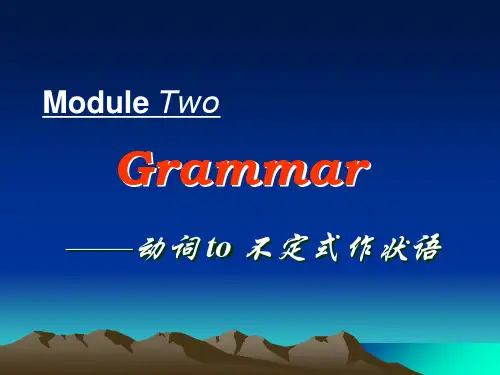
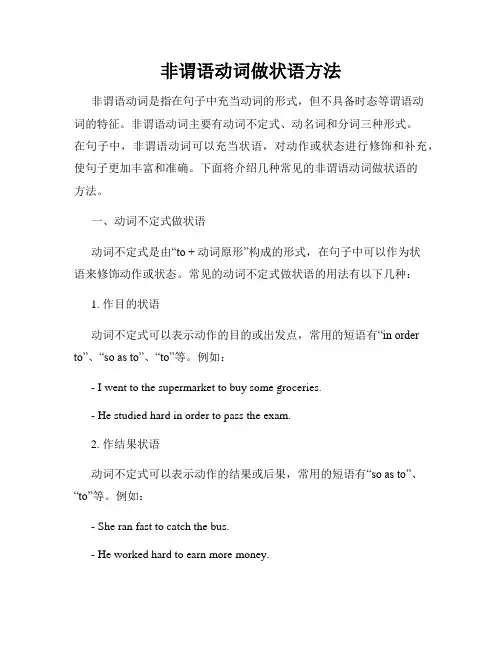
非谓语动词做状语方法非谓语动词是指在句子中充当动词的形式,但不具备时态等谓语动词的特征。
非谓语动词主要有动词不定式、动名词和分词三种形式。
在句子中,非谓语动词可以充当状语,对动作或状态进行修饰和补充,使句子更加丰富和准确。
下面将介绍几种常见的非谓语动词做状语的方法。
一、动词不定式做状语动词不定式是由“to + 动词原形”构成的形式,在句子中可以作为状语来修饰动作或状态。
常见的动词不定式做状语的用法有以下几种:1. 作目的状语动词不定式可以表示动作的目的或出发点,常用的短语有“in order to”、“so as to”、“to”等。
例如:- I went to the supermarket to buy some groceries.- He studied hard in order to pass the exam.2. 作结果状语动词不定式可以表示动作的结果或后果,常用的短语有“so as to”、“to”等。
例如:- She ran fast to catch the bus.- He worked hard to earn more money.动词不定式可以表示动作的方式,常用的短语有“to”、“in order to”等。
例如:- They danced together to celebrate the victory.- He spoke loudly to make himself heard.4. 作原因状语动词不定式可以表示动作的原因,常用的短语有“for”、“to”等。
例如:- She apologized to him for being late.- He thanked her for helping him.二、动名词做状语动名词是由动词加上-ing构成的名词形式,具有动词和名词的特点,可以作为状语来修饰动作或状态。
常见的动名词做状语的用法有以下几种:1. 作原因状语动名词可以表示动作的原因,常用的短语有“by”、“by means of”等。
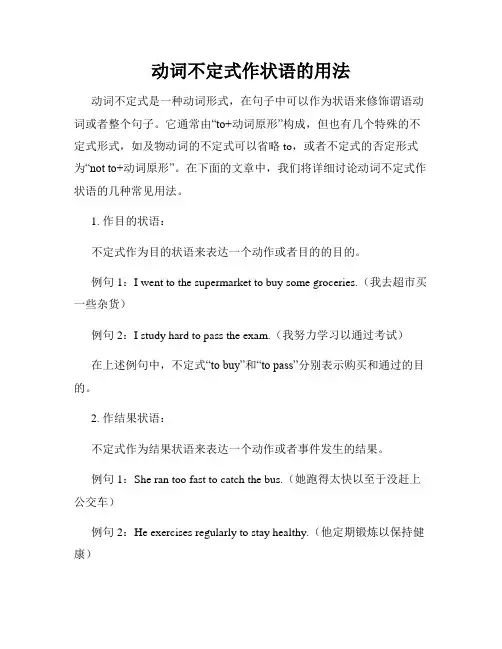
动词不定式作状语的用法动词不定式是一种动词形式,在句子中可以作为状语来修饰谓语动词或者整个句子。
它通常由“to+动词原形”构成,但也有几个特殊的不定式形式,如及物动词的不定式可以省略to,或者不定式的否定形式为“not to+动词原形”。
在下面的文章中,我们将详细讨论动词不定式作状语的几种常见用法。
1. 作目的状语:不定式作为目的状语来表达一个动作或者目的的目的。
例句1:I went to the supermarket to buy some groceries.(我去超市买一些杂货)例句2:I study hard to pass the exam.(我努力学习以通过考试)在上述例句中,不定式“to buy”和“to pass”分别表示购买和通过的目的。
2. 作结果状语:不定式作为结果状语来表达一个动作或者事件发生的结果。
例句1:She ran too fast to catch the bus.(她跑得太快以至于没赶上公交车)例句2:He exercises regularly to stay healthy.(他定期锻炼以保持健康)在上述例句中,不定式“to catch”和“to stay”分别表示未能赶上和保持健康的结果。
3. 作方式状语:不定式作为方式状语来描述一个动作或者事件的方式。
例句1:He spoke in a soft voice to not disturb others.(他小声说话以免打扰其他人)例句2:They walked slowly to enjoy the beautiful scenery.(他们慢慢地走以欣赏美景)在上述例句中,不定式“to not disturb”和“to enjoy”分别表示不打扰和欣赏的方式。
4. 作条件状语:不定式作为条件状语来描述一个条件或者前提。
例句1:In order to pass the test, you need to study hard.(为了通过考试,你需要努力学习)例句2:To be successful, you have to work hard.(要成功,你必须努力工作)在上述例句中,不定式“to pass”和“to be successful”分别表示通过和成功的条件。
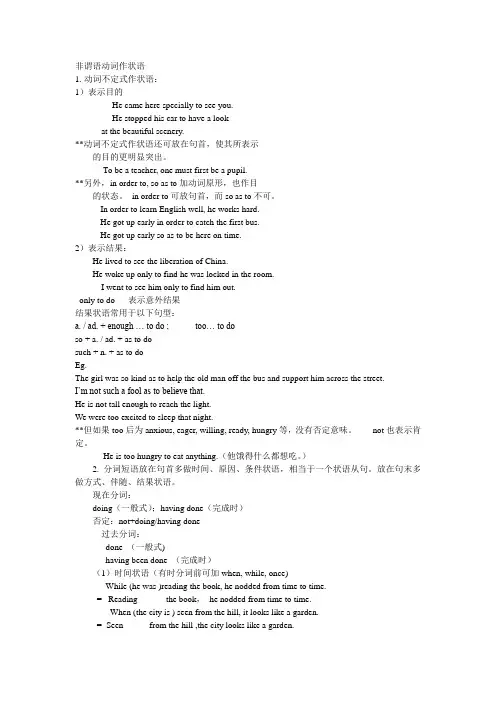
非谓语动词作状语1.动词不定式作状语:1)表示目的--- He came here specially to see you.--- He stopped his car to have a lookat the beautiful scenery.**动词不定式作状语还可放在句首,使其所表示的目的更明显突出。
--- To be a teacher, one must first be a pupil.**另外,in order to, so as to加动词原形,也作目的状态。
in order to可放句首,而so as to不可。
-- In order to learn English well, he works hard.-- He got up early in order to catch the first bus.-- He got up early so as to be here on time.2)表示结果:He lived to see the liberation of China.He woke up only to find he was locked in the room.I went to see him only to find him out.only to do 表示意外结果结果状语常用于以下句型:a. / ad. + enough … to do ; too… to doso + a. / ad. + as to dosuch + n. + as to doEg.The girl was so kind as to help the old man off the bus and support him across the street.I’m not such a fool as to believe that.He is not tall enough to reach the light.We were too excited to sleep that night.**但如果too后为anxious, eager, willing, ready, hungry等,没有否定意味。
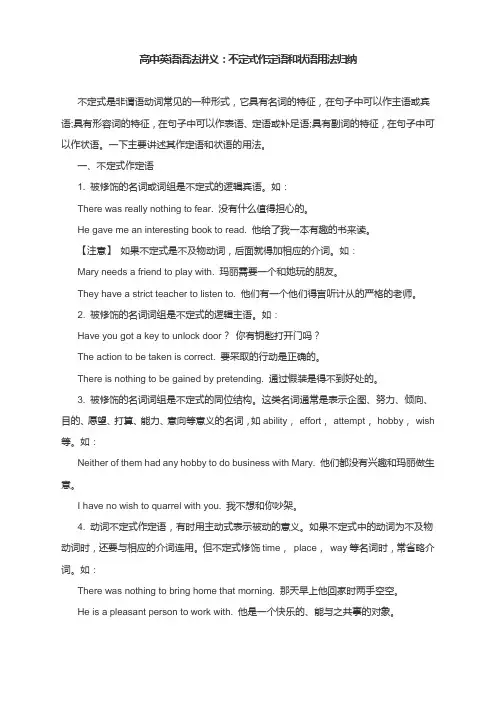
高中英语语法讲义:不定式作定语和状语用法归纳不定式是非谓语动词常见的一种形式,它具有名词的特征,在句子中可以作主语或宾语;具有形容词的特征,在句子中可以作表语、定语或补足语;具有副词的特征,在句子中可以作状语。
一下主要讲述其作定语和状语的用法。
一、不定式作定语1. 被修饰的名词或词组是不定式的逻辑宾语。
如:There was really nothing to fear. 没有什么值得担心的。
He gave me an interesting book to read. 他给了我一本有趣的书来读。
【注意】如果不定式是不及物动词,后面就得加相应的介词。
如:Mary needs a friend to play with. 玛丽需要一个和她玩的朋友。
They have a strict teacher to listen to. 他们有一个他们得言听计从的严格的老师。
2. 被修饰的名词词组是不定式的逻辑主语。
如:Have you got a key to unlock door?你有钥匙打开门吗?The action to be taken is correct. 要采取的行动是正确的。
There is nothing to be gained by pretending. 通过假装是得不到好处的。
3. 被修饰的名词词组是不定式的同位结构。
这类名词通常是表示企图、努力、倾向、目的、愿望、打算、能力、意向等意义的名词,如ability,effort,attempt,hobby,wish 等。
如:Neither of them had any hobby to do business with Mary. 他们都没有兴趣和玛丽做生意。
I have no wish to quarrel with you. 我不想和你吵架。
4. 动词不定式作定语,有时用主动式表示被动的意义。
如果不定式中的动词为不及物动词时,还要与相应的介词连用。


动词不定式做目的状语动词不定式作为状语在英语中使用广泛,其中以不定式做目的状语的句型尤为常见。
本文将分别介绍该句型的用法和常见的翻译方法。
一、动词不定式做目的状语的用法动词不定式做目的状语通常放在句尾,用于表示一个动作或行为发生的目的或目标,常用的结构是"to+动词原形",如:- He went to the supermarket to buy some groceries. 他去超市买了一些杂货。
- She studies hard to get good grades. 她努力学习以获得好成绩。
- They took a cab to get to the train station on time. 他们乘出租车以便准时到达火车站。
二、动词不定式做目的状语的翻译方法在翻译中,我们需要注意句子的主语、动词、宾语和to不定式一起构成句子的表达方式。
常用的翻译方法有以下三种:1. 直接翻译直接翻译是最常用、最基础的翻译方法。
具体操作是将原文中的to不定式直接翻译成为汉语中的"为了"或"以便"等连接词。
例如:- He went to the supermarket to buy some groceries. 他去超市买了一些杂货。
- 翻译为:他去超市是为了买一些杂货。
2. 忽略to不定式在某些情况下,汉语中省略某些无实义的连接词是比较自然的表达方式,这种方法也适用于不定式做目的状语的翻译。
例如:- She studies hard to get good grades. 她努力学习以获得好成绩。
- 翻译为:她努力学习获得好成绩。
3. 翻译为“为了”翻译为"为了"是一种泛化的表达方法,它将原文中的to不定式整体翻译成"为了",以简化了句子的表达,这种方法尤其适用于一些长句。
例如:- They took a cab to get to the train station on time. 他们乘出租车以便准时到达火车站。
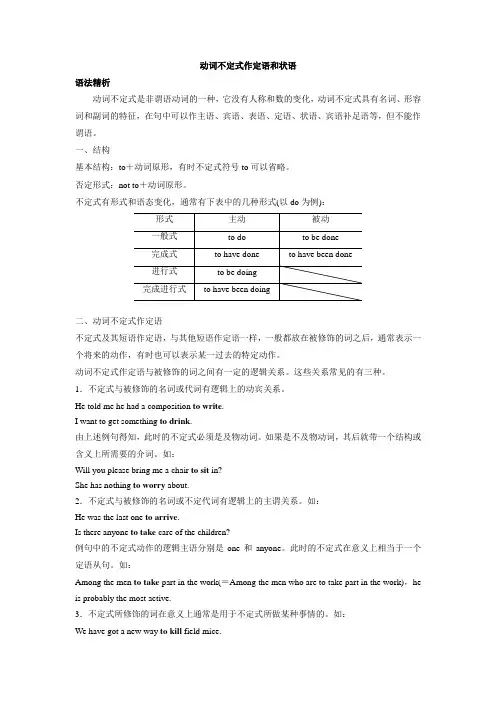
动词不定式作定语和状语语法精析动词不定式是非谓语动词的一种,它没有人称和数的变化,动词不定式具有名词、形容词和副词的特征,在句中可以作主语、宾语、表语、定语、状语、宾语补足语等,但不能作谓语。
一、结构基本结构:to+动词原形,有时不定式符号to可以省略。
否定形式:not to+动词原形。
不定式有形式和语态变化,通常有下表中的几种形式(以do为例):二、动词不定式作定语不定式及其短语作定语,与其他短语作定语一样,一般都放在被修饰的词之后,通常表示一个将来的动作,有时也可以表示某一过去的特定动作。
动词不定式作定语与被修饰的词之间有一定的逻辑关系。
这些关系常见的有三种。
1.不定式与被修饰的名词或代词有逻辑上的动宾关系。
He told me he had a composition to write.I want to get something to drink.由上述例句得知,此时的不定式必须是及物动词。
如果是不及物动词,其后就带一个结构或含义上所需要的介词。
如:Will you please bring me a chair to sit in?She has nothing to worry about.2.不定式与被修饰的名词或不定代词有逻辑上的主谓关系。
如:He was the last one to arrive.Is there anyone to take care of the children?例句中的不定式动作的逻辑主语分别是one和anyone。
此时的不定式在意义上相当于一个定语从句。
如:Among the men to take part in the work(=Among the men who are to take part in the work),he is probably the most active.3.不定式所修饰的词在意义上通常是用于不定式所做某种事情的。
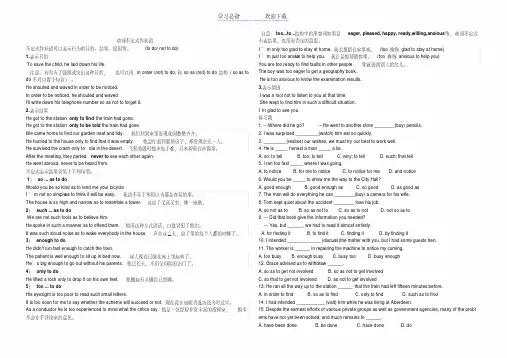
动词不定式作状语不定式作状语可以表示行为的目的、结果、原因等。
(to do/ not to do)1.表示目的To save the child, he laid down his life.注意:有时为了强调或突出这种目的,也可以用in order (not) to do,和so as (not) to do结构(so as to do不可以置于句首)。
He shouted and waved in order to be noticed.In order to be noticed, he shouted and wavedI'll write down his telephone number so as not to forget it.2.表示结果He got to the station only to find the train had gone.He got to the station only to be told the train had gone.We came home to find our garden neat and tidy.我们回到家里发现花园整整齐齐。
He hurried to the house only to find that it was empty.他急忙赶到那所房子,却发现空无一人。
He survived the crash only to die in the desert.飞机坠毁时他幸免于难,后来却死在沙漠里。
After the meeting, they parted, never to see each other again.He went abroad, never to be heard from.不定式表示结果常见于下列句型。
1)so ... as to doWould you be so kind as to lend me your bicycleI’m not so simple as to think it will be easy.我决不至于笨得以为那是容易的事。


动词不定式作状语八种用法1. 作目的状语目的状语的作用也叫作“为了达到某种目的而去做某事”,它体现了动作的目的,结构上通常由“to do”构成,“to do”可以是表示动作、状态或态度等各种类型的不定式。
例如:He stoped working in order to rest. 他停下了工作以便休息。
原因状语的作用也叫作“由于某种原因而去做某事”,它也是动作的目的,由“because of, for, due to”等词引导,“because of, for, due to”后面接的还可以是动名词或动词不定式。
例如:条件状语的作用也叫作“如果……就……”,即以“if”引导,“if”之后跟随的可以是动名词或动词不定式。
例如:If I were you, I wouldn't go there. 如果我是你,我就不去那里了。
As soon as he got into the classroom,he started writing on the blackboard. 他一进教室就开始在黑板上写东西了。
让步状语的作用也叫作“尽管……也……”,也叫作“notwithstanding”,表示对某种情况的认可与接受,以“although, though, even though, no matter how”引导,“although, though, even though, no matter how” 后面接的是名词或动词不定式。
例如:6. 作结果状语结果状语的作用也叫作“以致……”,以“so”,“so…that”,“such…that”引导,“so”,“so…that”,“such…that”后面有时可接动名词,有时也可接动词不定式。
例如:The result was so bad that he had to quit. 结果如此糟糕以致他不得不辞职。
He went inside with singing. 他唱着歌走进去了。
高中英语知识点归纳非谓语动词作状语的形式非谓语动词是英语中的一种特殊形式,作为谓语动词的补充或者修饰语。
在高中英语中,非谓语动词经常用作状语来修饰句子的主语、谓语、宾语或者其他成分,起到进一步补充说明的作用。
本文将对高中英语知识点进行归纳,总结非谓语动词作状语的各种形式。
一、动词不定式作状语1.目的状语:用于表示动作的目的或意图。
例句:She hurried to the station to catch the early train.2.结果状语:用于表示动作的结果。
例句:He studied hard to pass the exam.3.原因状语:用于表示某种原因或动机。
例句:He went to the supermarket to buy some groceries.4.方式状语:用于表示动作的方式或者手段。
例句:She walked slowly to avoid slipping on the ice.5.条件状语:用于表示某种条件下发生的动作。
例句:He needs to finish his homework to go out.6.时间状语:用于表示动作发生的时间。
例句:I woke up early to catch the sunrise.二、动名词作状语1.原因状语:用于表示某种原因或动机。
例句:She left the party, feeling bored.2.方式状语:用于表示动作的方式或者手段。
例句:He crossed the river, swimming.3.时间状语:用于表示动作发生的时间。
例句:She spent the whole afternoon chatting with her friends.4.伴随状语:用于表示动作的同时发生的状态。
例句:He walked down the street, whistling a tune.5.条件状语:用于表示某种条件下进行的动作。
动词不定式作状语重难点解读
动词不定式作状语可以说是中文中最为复杂的句式之一,在学习中文的过程中,不定式作状语也是最难以掌握的一部分。
把握不定式的用法,有助于我们更好地理解句子的意思,更准确地表达自己的思想。
首先,动词不定式作状语的基本格式是“主语+动词不定式+其他”,其中,动词不定式表示所描述的动作或状态,而动词不定式可以用于表示实义动词,助动词,介词短语,形容词等,动词不定式只能放在句首,后面跟着动词或其他词语,其后所跟的动词和词语都表达一个动态或状态,动词不定式作状语时,不定式前面的动词(实义动词或助动词)必须有实义,一般为表示动作的动词,例如:想、试着、尽量、想要等。
其次,动词不定式作状语的格式有多种变化,这其中最常用的主要有“主语+动词不定式+句子”和“主语+实义动词+动词不定式+句子”。
动词不定式作状语的句子可以表达状态、动作、建议、意图或者描述某种情景等,例如:我试图尽可能快地把工作做完;她想把这篇文章写得更精彩;大家努力做好每一项工作;他们每次都尽量多地吃水果。
此外,动词不定式作状语的另一个重要形式是“主语+实义动词+动词不定式+句子”,这种形式通常在句子中表达的是动作性的含义,可以用来表达一个具体的行为活动,与宾语无关,例如:她尽可能早
地回家;他必须尽快地赶到现场;我们每天努力工作;大家尽量分配更多的资源。
最后,动词不定式作状语可以用来表达期望、意图和看法,例如:我们希望尽力加快完成任务;他想尽可能多地阅读书籍;她尽可能多地利用这次机会;大家都应该尽量充分利用自己的时间。
总之,动词不定式作状语是中文中最难掌握的句式之一,了解其用法,不仅有助于我们更好地掌握句子的意思,而且有助于我们更准确地表达自己的思想。
动词不定式作状语 -。
状语从句作状语动词不定式和状语从句都可以作为状语来修饰句子中的动词、形容词或副词。
它们在功能上是相似的,但在用法和结构上略有不同。
本文将讨论动词不定式和状语从句在作状语时的用法和差异。
1.动词不定式作状语动词不定式作状语时,通常以不定式符号"to"开头,后接动词的原形形式。
它可以用于表示目的、目标、结果、原因、目的等不同的状语功能。
1.1 表示目的动词不定式可以表示动作的目的或意图。
例如:He went to the store to buy some groceries.(他去商店买些杂货。
)___ hard to pass the exam.(她努力研究以便通过考试。
)1.2 表示目标动词不定式可以表示动作的目标。
例如:___.(她想去看望她的祖父母。
)They plan to build a new house.(他们计划建一座新房子。
)1.3 表示结果动词不定式可以表示动作的结果。
例如:He worked hard to ___.(他努力工作以获得晋升。
)She saved money to buy a car.(她存钱买车。
)1.4 表示原因动词不定式可以表示动作的原因。
例如:___ project.(他熬夜完成他的项目。
)___.(他们去法国体验文化。
)1.5 表示条件动词不定式可以表示动作的条件。
例如:She needs to study hard to succeed.(她需要努力研究才能成功。
)He has to work ___.(他不得不加班以赶上截止日期。
)2.状语从句作状语状语从句是一个完整的句子,可以由连词引导,用以修饰句子中的动词、形容词或副词。
它可以用于表示时间、条件、原因、结果、方式等不同的状语功能。
2.1 表示时间状语从句可以表示动作发生的时间。
例如:When he arrived。
___ was already there.(当他到达时,每个人都已经在那里了。
动词不定式作状语《神奇的动词不定式作状语》嘿,同学们!你们知道什么是动词不定式作状语吗?一开始,我也和你们一样,脑袋里充满了大大的问号。
可后来呀,经过老师的讲解,我好像打开了一扇通往神奇语法世界的大门!就拿“To learn English well, we need to practice a lot.”这句话来说吧,“To learn English well”就是动词不定式作目的状语。
哎呀,这是不是有点复杂?其实呀,就好比我们要去一个好玩的地方,得先准备好背包一样,“To learn English well”就是为了达到“学好英语”这个目标而存在的。
再比如“He got up early to catch the first bus.”这里的“to catch the first bus”就是他早起的目的,是不是很像我们为了吃到喜欢的蛋糕,早早地跑去蛋糕店排队呀?有一次,在课堂上,老师问我们:“同学们,谁能来说说动词不定式作状语的例子呀?”大家都沉默不语,我心里也七上八下的,生怕老师点到我。
可没想到,我的好朋友小明勇敢地举起了手,大声说道:“To pass the exam, I study hard every day.”老师笑着表扬了他,我心里那叫一个羡慕呀!我暗暗下定决心,以后也要像小明一样勇敢回答问题。
还有一次做作业的时候,我遇到了一道难题,怎么都想不明白。
我着急地问同桌:“这道题里的动词不定式作状语到底是怎么回事呀?”同桌耐心地给我讲解:“你看,这里‘To finish the work on time, they worked overtime.’就是为了按时完成工作,所以才加班呀。
”听了他的解释,我恍然大悟,忍不住感叹:“原来这么简单,我怎么就没想到呢!”经过不断地学习和练习,我发现动词不定式作状语其实也没那么难嘛!它就像是给句子穿上了一件漂亮的衣服,让句子变得更加生动有趣。
动词不定式作状语
不定式作状语可以表示行为的目的、结果、原因等。
(to do/ not to do)
1.表示目的
To save the child, he laid down his life.
注意:有时为了强调或突出这种目的,也可以用in order (not) to do,和so as (not) to do结构(so as to do不可以置于句首)。
He shouted and waved in order to be noticed.
In order to be noticed, he shouted and waved
I'll write down his telephone number so as not to forget it.
2.表示结果
He got to the station only to find the train had gone.
He got to the station only to be told the train had gone.
We came home to find our garden neat and tidy.我们回到家里发现花园整整齐齐。
He hurried to the house only to find that it was empty.他急忙赶到那所房子,却发现空无一人。
He survived the crash only to die in the desert.飞机坠毁时他幸免于难,后来却死在沙漠里。
After the meeting, they parted, never to see each other again.
He went abroad, never to be heard from.
不定式表示结果常见于下列句型。
1)so ... as to do
Would you be so kind as to lend me your bicycle
I’m not so simple as to think it will be easy.我决不至于笨得以为那是容易的事。
The house is so high and narrow as to resemble a tower.这房子又高又窄,像一座塔。
2)such ... as to do
We are not such fools as to believe him.
He spoke in such a manner as to offend them.他用这种方式讲话,以致冒犯了他们。
It was such aloud noise as to wake everybody in the house.声音这么大,房子里的每个人都给吵醒了。
3)enough to do
He didn't run fast enough to catch the train.
The patient is well enough to sit up in bed now.病人现在已能在床上坐起来了。
He’s big enough to go out without his parents.他已长大,不用父母陪着出门了。
4)only to do
He lifted a rock only to drop it on his own feet. 他搬起石头砸自己的脚。
5)too ... to do
His eyesight is too poor to read such small letters.
It is too soon for me to say whether the scheme will succeed or not.现在说计划能否成功还为时过早。
As a conductor he is too experienced to mind what the critics say.他是一位经验非常丰富的指挥家,根本不会在乎评论家的意见。
注意:too...to...结构中的形容词如果是eager, pleased, happy, ready,willing,anxious等,动词不定式不表结果,也没有否定的意思。
I’m only too glad to stay at home.我太想留在家里啦。
(too修饰glad to stay at home)
I’m just too anxious to help you.我正是想帮助你哩。
(too修饰anxious to help you)
You are too ready to find faults in other people.你就爱找别人的岔儿。
The boy was too eager to get a geography book.
He is too anxious to know the examination results.
3.表示原因
I was a fool not to listen to you at that time.
She wept to find him in such a difficult situation.
I’m glad to see you.
练习题
1. ---Where did he go? ---He went to another store ________(buy) pencils.
2. I was surprised _________(watch) him eat so quickly.
3. _________(realise) our wishes, we must try our best to work well.
4. He is _____ honest a man _____ a lie.
A. so; to tell
B. too; to tell
C. very; to tell
D. such; that tell
5. I ran too fast _____ where I was going.
A. to notice
B. for me to notice
C. to notice for me
D. and notice
6. Would you be _____ to show me the way to the City Hall?
A. good enough
B. good enough as
C. so good
D. as good as
7. The man will do everything he can ________(buy) a camera for his wife.
8. Tom kept quiet about the accident ________ lose his job.
A. so not as to
B. so as not to
C. so as to not
D. not so as to
9. --- Did that book give the information you needed?
--- Yes, but ______, we had to read it almost entirely.
A. for finding it
B. to find it
C. finding it
D. by finding it
10. I intended _____________ (discuss)the matter with you, but I had some guests hen.
11. The worker is ______ in repairing the machine to notice my coming.
A. too busy
B. enough busy
C. busy too
D. busy enough
12. Grace advised us to withdraw ______.
A. so as to get not involved
B. so as not to get involved
C. so that to get not involved
D. as not to get involved
13. He ran all the way up to the station ______ that the train had left fifteen minutes before.
A. in order to find
B. so as to find
C. only to find
D. such as to find
14. I had intended ___________ (visit) him while he was living at Aberdeen.
15. Despite the earnest efforts of various private groups as well as government agencies, many of the probl ems have not yet been solved, and much remains to ______.
A. have been done
B. be done
C. have done
D. do。